Magnetohydrodynamik
Magnetohydrodynamics (MHD) is the research area focusing on the dynamics of electrically
conducting liquids under the influence of electromagnetic fields. The research activities
at HZDR cover a wide range from fundamental to applied research comprising activities in
the fields of high-temperature energy conversion systems, new kinds of liquid metal batteries,
the production of solar-grade silicon, CO2 free production of hydrogen, liquid metal targets
in modern neutron or particle sources and transmutation systems, casting and solidification
of steel and light metals, welding and soldering processes, to basic laboratory experiments
with relevance to liquid metal cooled systems, materials processing as well as to geo- and astrophysics.
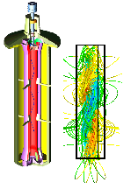
Geo/Astrophysics
Cosmic magnetic fields are generated by the hydromagnetic dynamo effect and play a crucial role in cosmic structure formation by means of the magnetorotational instability. Liquid metal experiments may help to understand those fundamental processes
More

Energy Storage and Energy Conversion with Liquid Metals
Liquid metals offer a range of benefits when used for energy storage and energy conversion: cost-effective production, high cycle numbers and high scalability
More
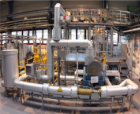
Model experiments for metallurgy and crystal growth processes
The optimization of processes in metallurgy or in the crystallization of semiconductor materials with regard to product quality and energy efficiency requires a profound understanding of the flow processes in the melts.
More
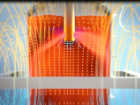
Measurement techniques for liquid metals
The knowledge of velocity structures or of the gas distribution in liquid metals is of great interest in laboratory experiments as well as in industrial applications. The opaqueness of those fluids prevents the use of well established optical methods. Additionally, the corrosiveness and the high temperatures are challenges for measurement techniques.
More
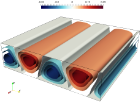
Rayleigh-Bénard convection in liquid metals
Thermally driven convection can be found in many areas of nature and technology. Particularly interesting from a geo-and astrophysical point of view are convection flows at very low Prandtl numbers, ie in fluids with low viscosity and particularly high thermal conductivity. Experiments with the lowest Prandtl numbers can only be achieved with liquid metals and pose a great challenge.
More
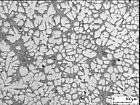
Solidification of metal alloys
Convective transport plays an important role in solidification processes. The application of electromagnetic stirring in solidifying melts is attractive because there is an active influence on the microstructural characteristics and thus on the mechanical properties via a completely contactless control of the flow.
More

Liquid metal multiphase flows
Liquid metal two-phase flows are of particular importance for many processes in metallurgy and metal casting. For example, the secondary-metallurgical treatment of liquid steel relies on the injection of purge gas for improving the steel cleanliness. Objectives are the enhancement of mixing and homogenization and the separation of inclusions by flotation.
More
recent ublirckations
in efereed journals and books


